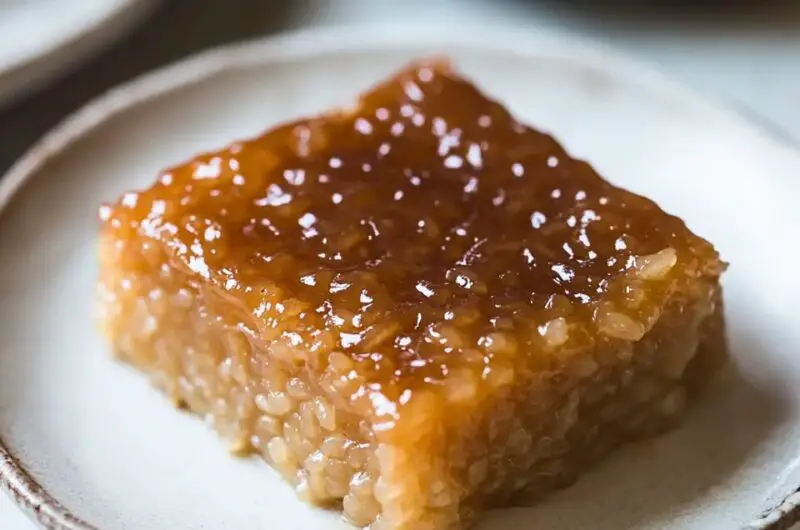Biko is a beloved Filipino sticky rice cake made from glutinous rice, coconut milk, and dark brown sugar. Known for its rich, chewy texture and sweet, caramel-like topping, Biko is a traditional dessert often served during celebrations, holidays, and family gatherings. This comforting, gluten-free, and vegan-friendly dish (when using coconut oil) is both nostalgic and crowd-pleasing. Its slow stovetop cooking and oven-baked finish create a luscious, dense, and deeply flavorful treat that tastes like home.
Full Recipe:
Ingredients
-
4 cups glutinous (sticky) rice
-
3 cans (14 oz each) full-fat coconut milk, divided
-
1½ cups water
-
2½ cups packed dark brown sugar, divided
-
¼ tsp kosher salt
Directions
1. Soak the rice:
Place glutinous rice in a large bowl, cover with cool water, and soak overnight. Drain and rinse before cooking.
2. Preheat oven:
Set your oven to 350°F (177°C) and grease a 9×13-inch baking pan with coconut oil, baking spray, or butter.
3. Cook the rice mixture:
In a large pot, combine the soaked rice with 1½ cups water and all but ¾ cup of the coconut milk. Bring to a simmer over medium heat, stirring frequently to prevent burning. Cook for 5–8 minutes until most liquid is absorbed.
4. Add sugar and salt:
Lower the heat. Stir in 1½ cups of the brown sugar and ¼ tsp salt. Continue cooking and stirring for another 5–8 minutes until the mixture thickens and the rice is fully cooked.
5. Transfer to baking pan:
Spread the thick rice mixture evenly into the prepared pan.
6. Make the topping:
In a small saucepan, combine the reserved ¾ cup coconut milk with the remaining 1 cup brown sugar. Bring to a boil, stir until dissolved, then let cool slightly for 3–5 minutes.
7. Add topping and bake:
Gently pour the caramel topping over the rice in the pan. Bake for 1 hour, or until the topping is bubbling and thickened.
8. Cool and serve:
Let the biko cool slightly before serving. The topping will be very hot. Serve warm or at room temperature.
Nutrients (Per serving, approximately 18 servings)
-
Calories: 420
-
Carbohydrates: 67g
-
Fat: 16g
-
Saturated Fat: 14g
-
Sugar: 32g
-
Protein: 4g
-
Fiber: 3g
-
Sodium: 55mg
Cultural Significance and Origins
Biko has long held a special place in Filipino culinary culture. As a traditional kakanin (rice-based delicacy), it is part of a broader family of native desserts that reflect the agricultural roots of the Philippines. Rice, particularly sticky or glutinous rice, is a foundational crop in the country, and coconut trees are abundant across its many islands. This makes Biko not only delicious but also deeply connected to the land and lifestyle of the Filipino people.
Typically served during fiestas, Christmas, birthdays, and undás (All Saints’ Day), Biko is often associated with togetherness and commemoration. In many Filipino households, the presence of Biko signals a special occasion—a dish that honors loved ones, both past and present.
What Makes Biko Special
What sets Biko apart from other rice cakes is its unique texture and flavor. Glutinous rice gives it a chewy, almost sticky base that contrasts beautifully with the sweet, slightly crispy caramel topping. The use of dark brown sugar infuses the cake with deep molasses-like richness, while the full-fat coconut milk adds creaminess and a subtle tropical aroma.
Unlike baked cakes that rely on flour and leavening agents, Biko gets its dense body from the slow cooking of the rice in coconut milk. The stovetop simmering helps the rice absorb flavor and moisture, while the final baking step allows the topping to bubble, thicken, and create a caramelized glaze.
The result is a dessert that feels indulgent yet earthy, rich yet simple—a dessert that doesn’t need frosting or embellishments to make a lasting impression.
Why This Recipe Works So Well
This particular Biko recipe is thoughtfully constructed to bring out the best in each component. The rice is soaked overnight, ensuring a soft, even texture when cooked. The initial simmer in coconut milk allows the rice to fully absorb flavor while becoming tender without turning mushy. Stirring in brown sugar and salt enhances the depth and balances the sweetness with a touch of savoriness.
The topping, made by simmering coconut milk and more dark brown sugar, transforms into a thick syrup that seeps into the rice while also setting on top into a sticky, glossy finish. Baking the entire dish allows the flavors to meld and the topping to develop that iconic golden-brown color and luscious consistency.
The recipe also provides flexibility—use coconut oil or butter for greasing the pan, and adjust sweetness or saltiness based on personal taste. Its ingredients are accessible in most grocery stores or Asian markets, making it easy to recreate authentic Filipino flavors in any kitchen.
A Dessert That’s Also Inclusive
One of the most remarkable aspects of Biko is its adaptability for various dietary preferences. It is naturally gluten-free, making it an excellent choice for those with gluten sensitivities. By using coconut oil instead of butter, the dish becomes entirely plant-based, making it vegan-friendly without sacrificing any richness.
Unlike many traditional baked goods, Biko contains no eggs, flour, or dairy in its base. This not only simplifies the ingredient list but also makes it a safe offering at potlucks and shared meals, especially when guests may have specific dietary restrictions.
Its rich flavor and dense texture also make it quite satisfying in small portions, meaning it stretches easily to serve a crowd.
When to Serve Biko
Biko shines at celebrations, but it is also perfect for everyday enjoyment. Slice it into squares for afternoon snacks, serve it warm with a cup of hot tea or coffee, or enjoy it as a comforting dessert after dinner. It travels well, making it ideal for picnics, parties, or food gifts wrapped in banana leaves or parchment paper.
During holidays like Christmas or New Year’s Eve, Biko often takes a prominent place on the dessert table alongside other kakanin such as puto, kutsinta, and sapin-sapin. Its golden topping and neatly sliced squares add visual appeal to any spread.
Because of its long shelf life at room temperature (typically up to 2–3 days), it can also be made ahead of time—perfect for event planning or meal prep.
Tips for Perfect Biko
To achieve the best results, use high-quality glutinous rice. Regular rice won’t give the sticky, cohesive texture that defines Biko. Make sure to soak the rice overnight to reduce cooking time and ensure even softness.
When cooking the rice mixture on the stovetop, stir frequently to prevent sticking and burning. Use a nonstick or heavy-bottomed pot if available. The mixture should thicken but remain moist enough to spread easily into the pan.
The topping should be thick but pourable—boiling the sugar and coconut milk together helps dissolve the sugar completely and creates that silky texture. Pour the topping gently over the rice and let it bake slowly; patience is key to allowing the top to caramelize properly.
Let the Biko cool slightly before slicing. It firms up as it sits, which makes for cleaner cuts and easier serving.
Why You’ll Love This Dessert
Biko is more than a dessert—it’s an experience. Its deep flavors, comforting texture, and cultural resonance make it an unforgettable treat. The richness of coconut milk, the molasses notes from brown sugar, and the soft chewiness of sticky rice combine into something soul-satisfying. It’s a dessert that feels like a warm hug, whether you grew up eating it or are discovering it for the first time.
You’ll love how this recipe brings joy to your kitchen with relatively little effort. You don’t need a mixer or special baking equipment—just a pot, a pan, and a spoon. And in return, you get a dessert that’s beautiful, delicious, and full of heart.
Conclusion
Biko is a timeless Filipino dessert that represents more than just sweetness—it reflects tradition, comfort, and togetherness. Whether served during a joyful celebration or as a treat to warm a regular day, it always delivers satisfaction. With its naturally gluten-free and vegan-friendly profile, it’s an inclusive dish that can be enjoyed by nearly everyone. This easy-to-follow recipe allows anyone to experience the joy of making and sharing Biko. Its sticky, caramelized goodness is guaranteed to leave a lasting impression, one sweet square at a time.








